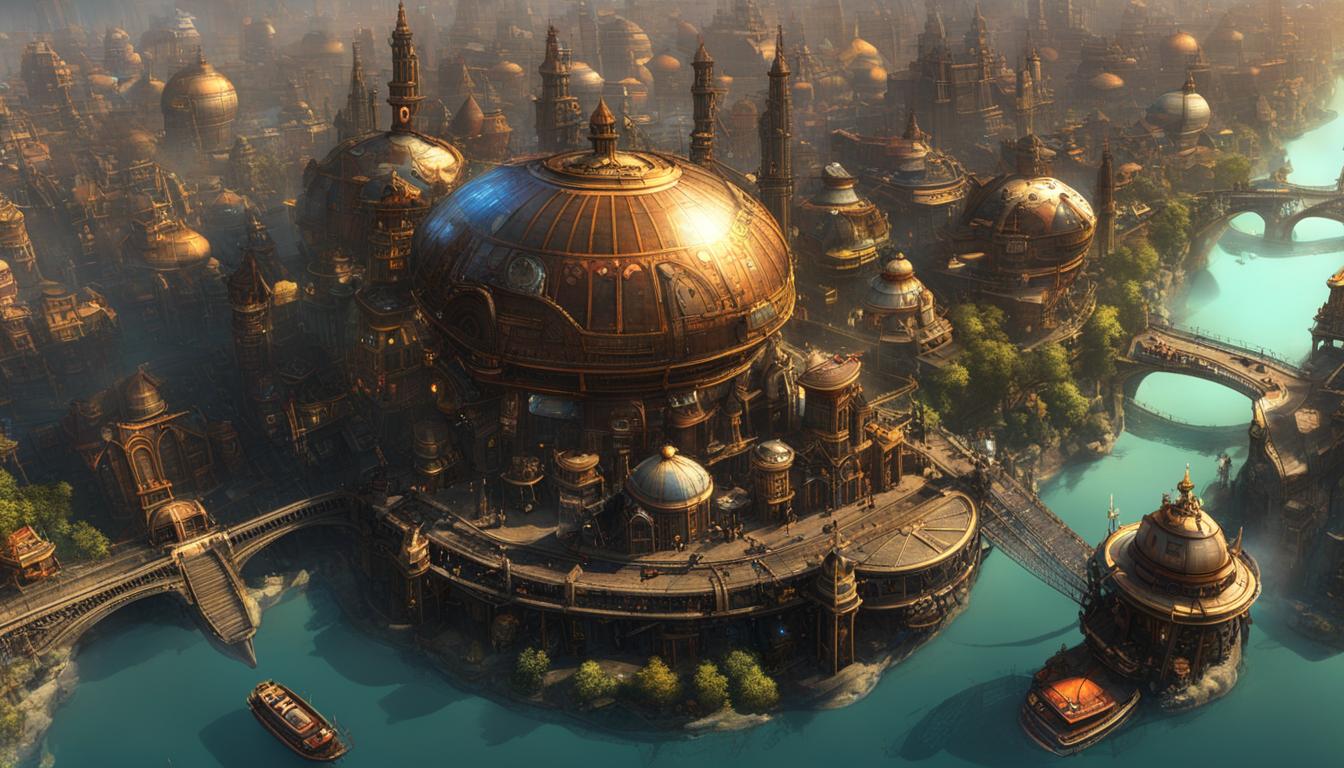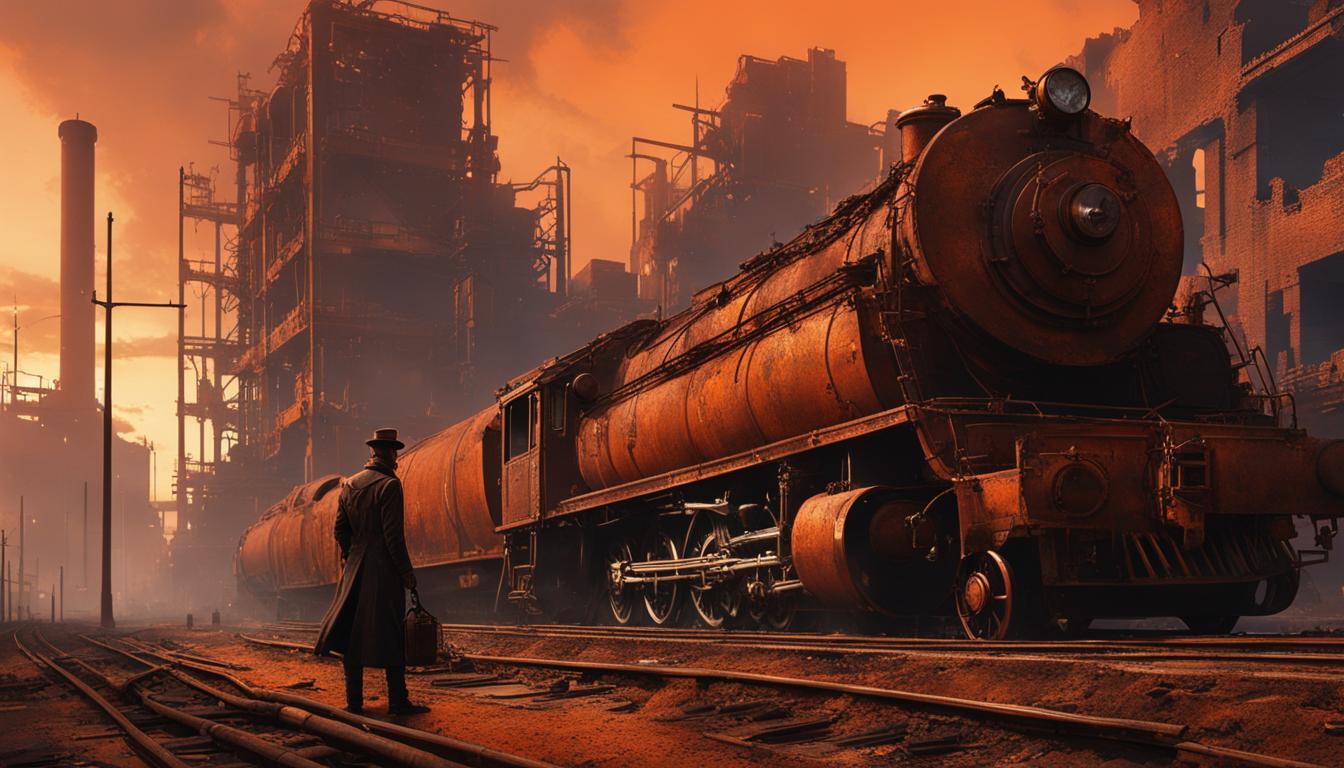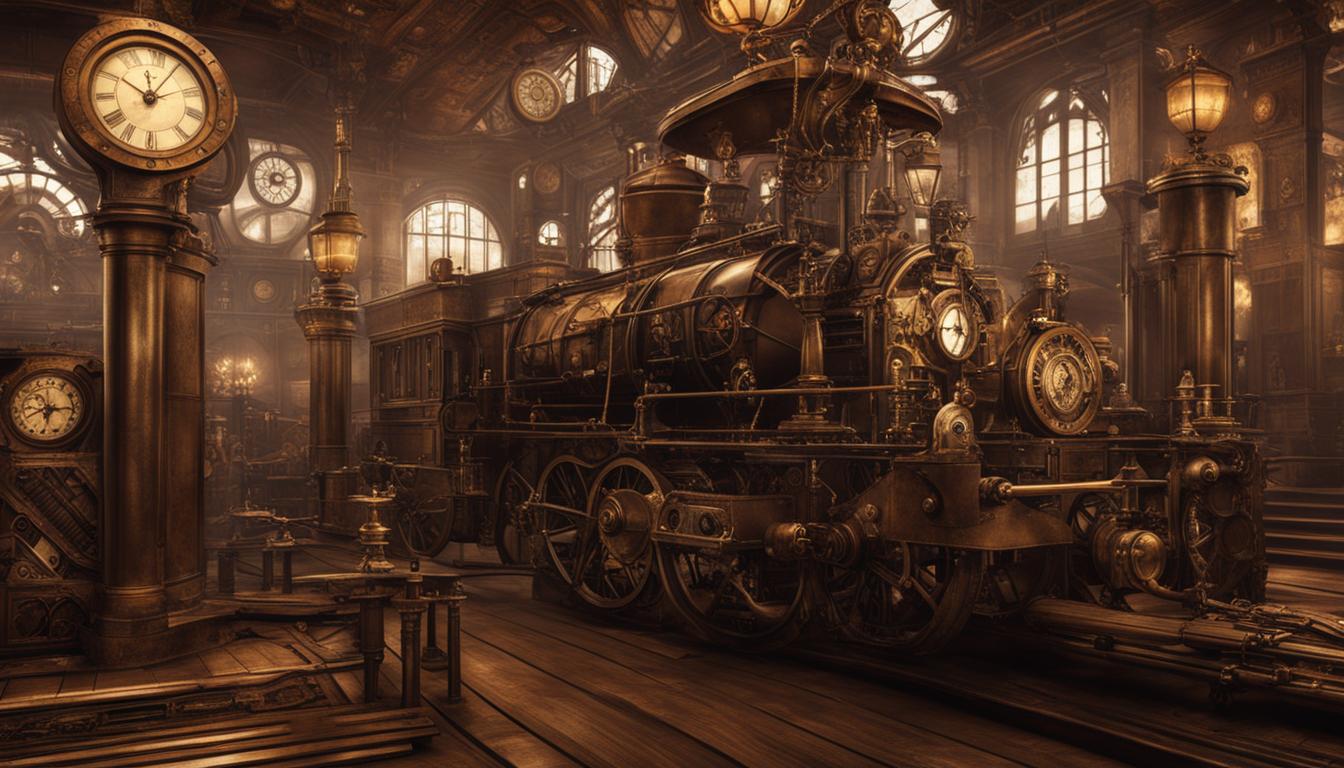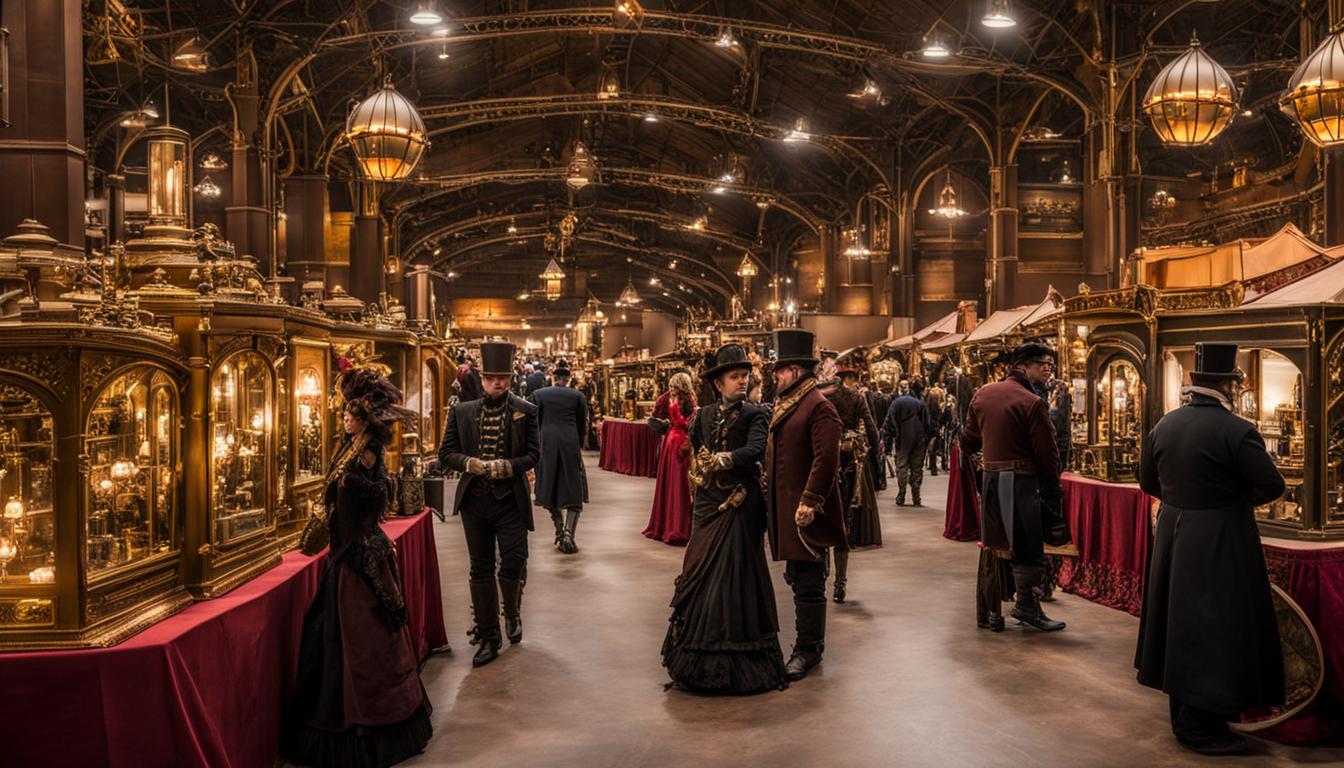Steampunk literature has carved a unique niche in the literary world, blending elements of Victorian elegance with futuristic technology. From tight corsets to high-tech gadgets, this genre has created a captivating world where past and future collide. Alongside the intriguing aesthetics, steampunk novels have introduced us to a plethora of iconic characters, each leaving an indelible mark on the genre’s rich tapestry. Let’s embark on a journey through time and discover some of the famous steampunk literary characters who have captured our imaginations.
Key Takeaways:
- Steampunk literature combines Victorian aesthetics with futuristic technology.
- Iconic characters in steampunk books have captivated readers with their adventures.
- The fusion of history, science fiction, and fantasy makes steampunk storytelling unique.
- Jules Verne’s “Twenty Thousand Leagues Under the Sea” introduced the world to the enigmatic Captain Nemo.
- H.G. Wells’ “The Time Machine” showcased the fusion of Victorian aesthetics and scientific possibilities.
- Michael Moorcock’s “Warlord of the Air” explored an alternate timeline where steam-powered technology reigns supreme.
- “The Difference Engine” by William Gibson and Bruce Sterling delves into an alternative Victorian era influenced by advanced computing.
Jules Verne – Twenty Thousand Leagues Under the Sea
Jules Verne’s novel Twenty Thousand Leagues Under the Sea, published in 1870, is a cornerstone of the steampunk genre. Set in the Victorian era, the story takes readers on a thrilling journey aboard the Nautilus, a high-tech submarine. Led by the enigmatic Captain Nemo, the protagonist, Pierre Aronnax, discovers breathtaking underwater wonders while uncovering the mysteries surrounding Nemo’s motivations.
Verne’s masterful storytelling blends advanced technology with the intrigue of the 19th century, creating a world where steam-powered machinery and Victorian aesthetics reign supreme. This fusion of past and future, science fiction and adventure, makes Twenty Thousand Leagues Under the Sea an iconic steampunk novel.
“The sea is everything. It covers seven tenths of the terrestrial globe. Its breath is pure and healthy. It is an immense desert, where man is never lonely, for he feels life stirring on all sides.” – Jules Verne
Twenty Thousand Leagues Under the Sea captures the essence of steampunk, with its exploration of advanced technology, hidden societies, and larger-than-life characters. Verne’s visionary work laid the foundation for the genre, inspiring future generations of authors to continue expanding the boundaries of steampunk literature.
Table: Notable Characters in Twenty Thousand Leagues Under the Sea
| Character | Description |
|---|---|
| Captain Nemo | An enigmatic and mysterious figure who commands the Nautilus, a technologically advanced submarine. |
| Pierre Aronnax | A marine biologist who joins the Nautilus on its underwater explorations. |
| Conseil | A faithful servant and companion to Aronnax, accompanying him on his extraordinary adventures. |
| Ned Land | A skilled harpooner who becomes a reluctant member of the Nautilus’ crew. |
The characters in Twenty Thousand Leagues Under the Sea exemplify the archetypes found within the steampunk genre. From the enigmatic Captain Nemo to the curious Pierre Aronnax, each character brings depth and intrigue to the story, capturing the essence of the steampunk aesthetic.
Influential Steampunk Novels: H.G. Wells’ The Time Machine
One of the most influential steampunk novels of all time is H.G. Wells’ The Time Machine. Published in 1895, this captivating story takes readers on an incredible journey through time and showcases the fusion of Victorian aesthetics with scientific possibilities, which has become a hallmark of the steampunk genre. The Time Machine introduced the concept of time travel through the ingenious invention of a “time machine,” a term coined by Wells himself. This groundbreaking novel laid the foundation for the exploration of alternate timelines and futuristic technologies in steampunk literature.
“I gazed round the room and came upon a tall, white marble fireplace, with figures of putti and dolphins surmounting the mantelshelf.”
The protagonist of The Time Machine is known simply as the Time Traveller. As he embarks on his remarkable adventure, he travels over 800,000 years into the future and discovers a society divided into two distinct species. Wells’ vivid descriptions of this futuristic world and its inhabitants further establish the immersive nature of steampunk literature.
The Time Machine remains a beloved and influential steampunk novel, inspiring countless authors to explore similar themes of time travel, advanced technology, and the juxtaposition of past and future. Its impact on the genre continues to resonate with readers and serves as a testament to H.G. Wells’ visionary storytelling.
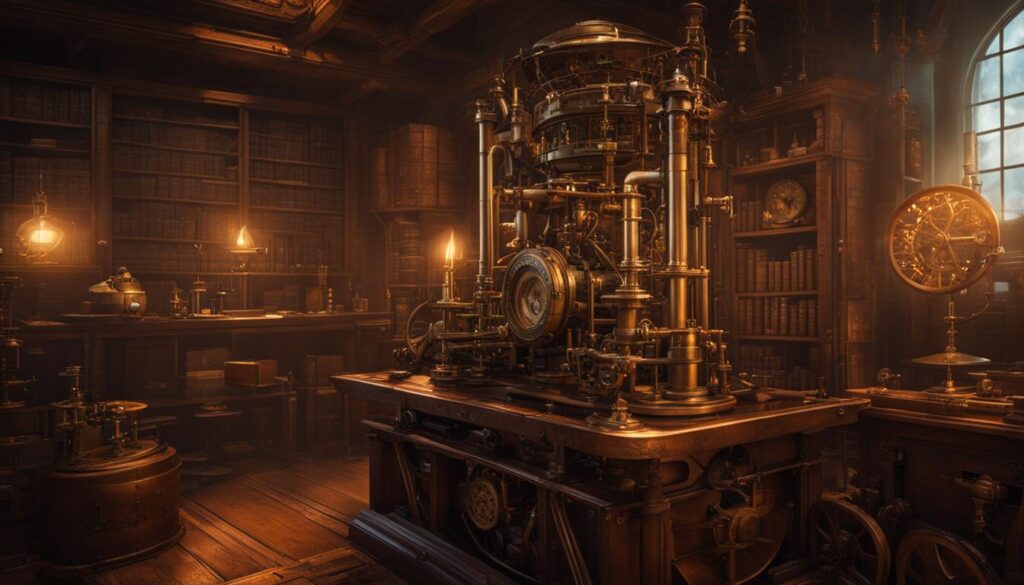
The Time Machine Table
| Key Elements | Significance |
|---|---|
| Time Travel | Introduces the concept of time travel through the invention of the “time machine,” a defining element of steampunk literature. |
| Victorian Aesthetics | Showcases the fusion of Victorian aesthetics with futuristic technologies, creating a unique steampunk setting. |
| Societal Exploration | Explores the division of future society into two distinct species, highlighting the social and evolutionary aspects of steampunk storytelling. |
Michael Moorcock – Warlord of the Air
Michael Moorcock’s novel, Warlord of the Air, published in 1971, played a pioneering role in the development of steampunk literature. Set in an alternate timeline where World War I never occurred, the story takes readers on a thrilling adventure through a world where Britain retains its colonial power through advanced steam-powered technology. The protagonist, Oswald Bastable, a 19th-century traveler, finds himself mysteriously transported to the year 1973, where he witnesses an eerie utopian society built upon the oppression of the colonies.
This groundbreaking novel combines historical elements with speculative fiction, paving the way for the emergence of the steampunk genre. Moorcock’s vivid portrayal of a steampunk world fueled by Victorian aesthetics and advanced technology captivated readers and inspired countless future writers and creators. The fusion of history, colonization, and steam-powered machines in Warlord of the Air continues to influence the genre to this day.
“A fascinating blend of alternate history, steampunk aesthetics, and social commentary, Warlord of the Air challenges our perception of traditional narratives and prompts us to question the impact of technology and imperialism on society.”
The Steampunk Pioneers
Michael Moorcock’s Warlord of the Air is considered one of the foundational works in the steampunk genre. Alongside other influential authors such as Jules Verne and H.G. Wells, Moorcock’s contribution to the development of steampunk literature cannot be understated. Warlord of the Air introduced readers to a world where history diverged from our own, creating a unique blend of past and future that has become a hallmark of the genre.
Steampunk literature often explores themes of technology, societal power structures, and the consequences of colonialism. Moorcock’s novel delves into these themes with a sense of adventure and intrigue that captures the essence of the steampunk aesthetic. Through the eyes of Oswald Bastable, readers experience a world where steampunk possibilities collide with historical realities, creating a thought-provoking narrative that continues to inspire and entertain steampunk enthusiasts worldwide.
| Michael Moorcock – Warlord of the Air | ||
|---|---|---|
| Publication Year | 1971 | |
| Genre | Steampunk, Alternate History | |
| Setting | Alternate timeline where World War I never occurred | |
| Main Protagonist | Oswald Bastable |
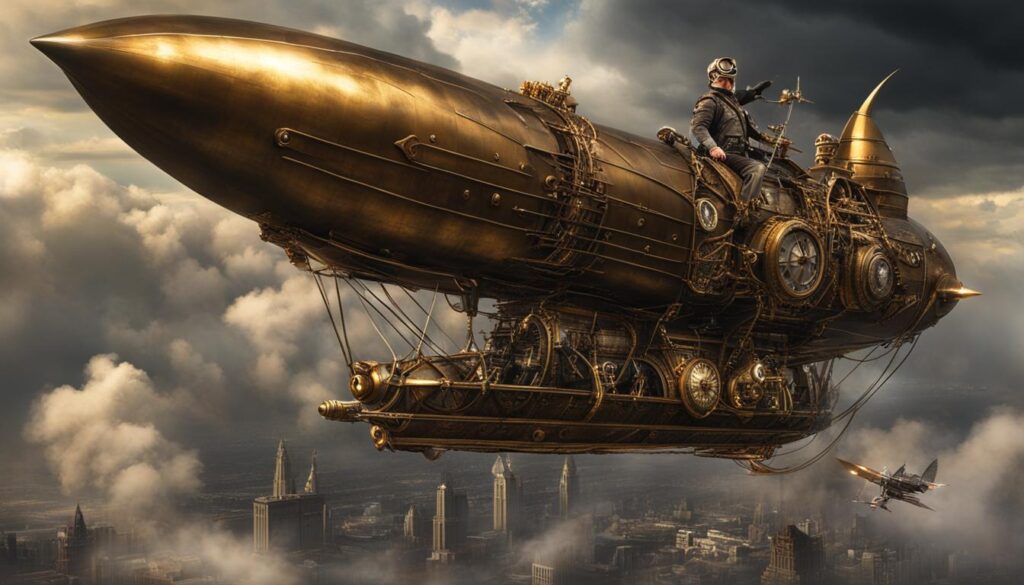
The Difference Engine – William Gibson and Bruce Sterling
The Difference Engine, written by William Gibson and Bruce Sterling, is a highly influential steampunk novel that takes readers on a thrilling journey through an alternative history where Charles Babbage’s analytical computer becomes a reality in the 19th century. This groundbreaking novel explores the impact of advanced technology on a Victorian society, combining elements of historical fiction, fantasy, and steampunk aesthetics.
Set in an era of steam-powered machinery and intricate clockwork, The Difference Engine dives deep into a world where punch cards and computational engines shape the course of history. The authors skillfully weave together multiple storylines, highlighting the personal struggles and ambitions of their characters against the backdrop of a society transformed by technological advancements.
“The Difference Engine presents a thought-provoking exploration of the possibilities of a steampunk future, seamlessly blending historical events, fictional characters, and bold imagination. Gibson and Sterling’s masterful storytelling and attention to detail make this novel a must-read for fans of the steampunk genre.”
The Difference Engine stands out as one of the most influential steampunk novels, with its richly detailed world-building, complex characters, and thought-provoking themes. It paved the way for a new wave of steampunk literature and continues to captivate readers with its unique blend of history, technology, and speculative fiction.
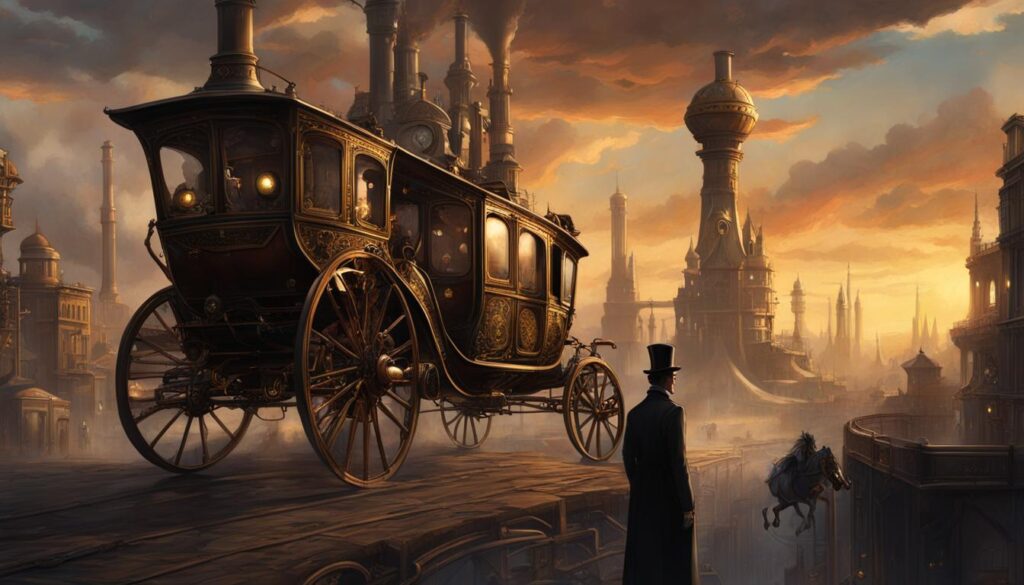
| Key Elements | Details |
|---|---|
| Publication Year | 1990 |
| Authors | William Gibson and Bruce Sterling |
| Genre | Steampunk, Historical Fiction, Science Fiction |
| Main Themes | Technological Advancements, Social Change, Alternative History |
| Impact on Steampunk Genre | Served as a major influence, shaping the direction of steampunk literature and inspiring future authors |
Conclusion
Steampunk literature has always been a playground for imaginative character development. From daring heroes to nefarious villains, the genre showcases a wide range of archetypes that continue to enthrall readers. These characters are the backbone of steampunk storytelling, embodying the fusion of history, technology, and adventure.
Among the top steampunk character archetypes, we find the brilliant inventors and masterful engineers who create marvels of steam-powered machinery. These ingenious minds, clad in goggles and leather, push the boundaries of science and shape the landscapes of their worlds. Equally compelling are the intrepid explorers, venturing into uncharted territories, unearthing secrets, and unraveling mysteries that blur the lines between the past and the future.
Notable steampunk heroes capture the essence of the genre, embodying the spirit of invention and rebellion against societal constraints. They fight against oppressive regimes, champion justice, and challenge the status quo. On the other side of the coin, the villains of steampunk are often charismatic, cunning, and sinister. They scheme in dark corners, wielding advanced technologies for their nefarious purposes, threatening the delicate balance between progress and chaos.
As steampunk continues to evolve, these iconic characters serve as a testament to the genre’s enduring allure. They inspire new generations of authors and readers, inviting them to explore the intricate worlds of brass, gears, and steam. So, enter the realm of steampunk literature and embark on adventures alongside these unforgettable heroes and villains, for they are the lifeblood of the genre’s captivating tales.
FAQ
What is steampunk literature?
Steampunk literature is a genre that combines elements of Victorian literature and cyberpunk, creating a unique blend of past and future.
What are the characteristics of steampunk aesthetics?
Steampunk aesthetics are characterized by tight corsets, goggles, top hats, and intricate costumes.
When did the steampunk genre emerge?
The steampunk genre emerged in the 90s and early 2000s and has since gained popularity in various forms.
What other forms has steampunk gained popularity in?
Steampunk has gained popularity in fashion, DIY projects, and mainstream media.
What genres are often combined with steampunk in novels?
Steampunk novels often incorporate elements of science fiction, fantasy, and speculative fiction.
What are some iconic steampunk novels?
Some iconic steampunk novels include Jules Verne’s Twenty Thousand Leagues Under the Sea, H.G. Wells’ The Time Machine, Michael Moorcock’s Warlord of the Air, and The Difference Engine by William Gibson and Bruce Sterling.
Who is Captain Nemo?
Captain Nemo is an enigmatic character in Jules Verne’s Twenty Thousand Leagues Under the Sea, leading an adventurous journey aboard the high-tech submarine Nautilus.
What is The Time Machine about?
The Time Machine, written by H.G. Wells, follows the Time Traveller as he travels over 800,000 years into the future and discovers a divided society.
What is Warlord of the Air about?
Warlord of the Air, written by Michael Moorcock, explores an alternate timeline where Britain retains power over its colonies through advanced steam-powered technology.
What is The Difference Engine about?
The Difference Engine, written by William Gibson and Bruce Sterling, is set in an alternative history where Charles Babbage invents the first computer and explores the impact of the Industrial Revolution and the computer age.
What are some iconic characters in steampunk literature?
Iconic characters in steampunk literature include Captain Nemo, the Time Traveller, Oswald Bastable, and various characters from The Difference Engine.

